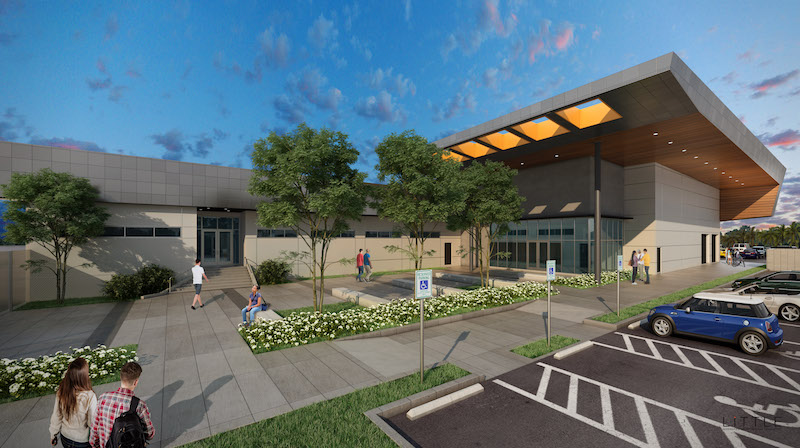On May 13, C.W. Driver, in partnership with Little Diversified Architectural Consulting, broke ground on the Kinesiology and Athletics Complex at Orange Coast College, a $36 million, 88,000-sf building within an Education sector that typically accounts for more than half of this Pasadena, Calif.-based general contractor’s annual revenue.
C.W. Driver, the oldest licensed builder headquartered in Southern California, is celebrating its 100th anniversary this year, and is showing little sign of slowing down. The company, with seven offices and 365 employees across California, generates between $700 million and $850 million per year in revenue.
In a consolidating industry where firms are frenetically acquiring new practices and disciplines to stay competitive, C.W. Driver remains an anomaly: a GC that builds almost exclusively in one state. Its portfolio includes academic, entertainment and sports, retail, civic and cultural, office, commercial hospitality and gaming, healthcare, residential and senior living.
“It’s not that we haven’t tried in the past” to diversify, says Karl Kreutziger, the firm’s president, who spoke with BD+C last week. At one time, C.W. Driver was self-performing concrete and drywall. It also once had an international business in Singapore.
Kreutziger, who has been with the firm since 2011, attributes its longevity to sticking with its core competencies and focusing the bulk of its work in the Greater Los Angeles market. (Eighty percent of its revenue comes from repeat customers.)
The company also has management continuity, starting with its CEO Dana Roberts, who has been with C.W. Driver for 48 years. In the 1990s, Roberts brought in two partners: CFO Bessie Kouvara, who retired in 2017; and Executive Vice President John Janacek, who oversees estimating.

Karl Kreutziger, C.W.Driver's president since 2011, attributes his company's longevity, in part, to its careful selection of projects. Image: C.W. Driver
The company was founded in 1919 by John McDonald and Clarence Wike Driver, the latter of whom had been working for one of the oldest architectural firms in L.A. During its first decade in business, C.W. Driver worked mostly on smaller projects. Driver’s son, Douglas, led the company through its next era and was active until 1987, when he turned over the reins to Roberts.
At a time when recruiting and retaining talent are challenges for many AEC firms, C.W. Driver has been able to hold onto its employees in part by offering some of them ownership in the company. It currently has 25 owners. And over the past two years, says Kreutziger, “we’ve had some ‘boomerangs,’ people who had left the company and have returned.” The fact that it offers full health insurance to all of its employees doesn’t hurt, either.
Like other GCs, C.W. Driver must deal with labor shortages. Keeping its trades on board, says Kreutziger, starts with a focused business development strategy “that identifies the projects we can be successful doing.” That requires early involvement at the preconstruction level, and then “committing to our key trade partners,” he says.
To avoid commoditizing its services, C.W. Driver steers away from design-bid-build projects, which account for less than 2% of its annual revenue. And while it has done work in Nevada, C.W. Driver usually passes on projects outside of its primary markets because, explains Kreutziger, “we just can’t get the [subs] to go there.”
As it moves into its second century, C.W. Driver wants to continue to grow organically. Kreutziger says the firm has been spending more time lately on succession planning and employee training. It also wants to make sure it is ahead of emerging markets like modular and panelized construction.
The firm is open, albeit cautiously, to new ventures that include acquisition. In August 2013, C.W. Driver acquired Good & Roberts, a 34-year-old San Diego-based construction company, which helped to bolster a market where C.W. Driver had been growing since 2006.
C.W. Driver also operates Driver SPG, an internal group it formed in 2011 that specializes in tenant improvement projects ranging from $500,000 to $15 million. Driver SPG represents about $80 million of C.W. Driver’s annual revenue, and “there’s a lot of crossover clients,” says Kreutziger.

C.W. Driver is the oldest liscensed builder headquartered in Southern California, a state where the GC continues to do most of its work. Image: C.W. Driver
Related Stories
MFPRO+ News | Sep 24, 2024
Major Massachusetts housing law aims to build or save 65,000 multifamily and single-family homes
Massachusetts Gov. Maura Healey recently signed far-reaching legislation to boost housing production and address the high cost of housing in the Bay State. The Affordable Homes Act aims to build or save 65,000 homes through $5.1 billion in spending and 49 policy initiatives.
AEC Tech | Sep 24, 2024
Generative AI can bolster innovation in construction industry
Jeff Danley, Associate Technology and Innovation Consultant at Burns & McDonnell, suggests several solutions generative AI could have within the construction industry.
Mixed-Use | Sep 19, 2024
A Toronto development will transform a 32-acre shopping center site into a mixed-use urban neighborhood
Toronto developers Mattamy Homes and QuadReal Property Group have launched The Clove, the first phase in the Cloverdale, a $6 billion multi-tower development. The project will transform Cloverdale Mall, a 32-acre shopping center in Toronto, into a mixed-use urban neighborhood.
3D Printing | Sep 17, 2024
Alquist 3D and Walmart complete one of the nation’s largest free-standing, 3D-printed commercial structures
Walmart has completed one of the largest free-standing, 3D-printed commercial structures in the US. Alquist 3D printed the almost 8,000-sf, 20-foot-high addition to a Walmart store in Athens, Tenn. The expansion, which will be used for online pickup and delivery, is the first time Walmart has applied 3D printing technology at this scale.
Retail Centers | Sep 17, 2024
Thinking outside the big box (store)
For over a decade now, the talk of the mall industry has been largely focused on what developers can do to fill the voids left by a steady number of big box store closures. But what do you do when big box tenants stay put?
Government Buildings | Sep 17, 2024
OSHA’s proposed heat standard published in Federal Register
The Occupational Safety and Health Administration (OSHA) has published a proposed standard addressing heat illness in outdoor and indoor settings in the Federal Register. The proposed rule would require employers to evaluate workplaces and implement controls to mitigate exposure to heat through engineering and administrative controls, training, effective communication, and other measures.
Codes and Standards | Sep 17, 2024
New California building code encourages, but does not mandate heat pumps
New California homes are more likely to have all-electric appliances starting in 2026 after the state’s energy regulators approved new state building standards. The new building code will encourage installation of heat pumps without actually banning gas heating.
Codes and Standards | Sep 17, 2024
ASHRAE’s first group of certified decarbonization professionals announced
ASHRAE recently announced its inaugural cohort of Certified Decarbonization Professionals (CDPs). Individuals who earned this designation demonstrate competency to assess, analyze, and develop effective and sustainable strategies to reduce or eliminate the life-cycle carbon footprint of buildings.
Mass Timber | Sep 17, 2024
Marina del Rey mixed-use development is L.A.’s largest mass timber project
An office-retail project in Marina del Rey is Los Angeles’ largest mass timber project to date. Encompassing about 3 acres, the 42XX campus consists of three low-rise buildings that seamlessly connect with exterior walkways and stairways. The development provides 151,000 sf of office space and 1,500 sf of retail space.
Education Facilities | Sep 16, 2024
Hot classrooms, playgrounds spur K-12 school districts to go beyond AC for cooling
With hotter weather occurring during the school year, school districts are turning to cooling strategies to complement air conditioning. Reflective playgrounds and roads, cool roofs and window films, shade structures and conversion of asphalt surfaces to a natural state are all being tried in various regions of the country.

















